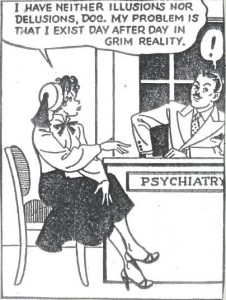I keep a cartoon in which a patient tells a flummoxed psychiatrist,
” I have neither illusions nor delusions, Doc. My problem is that I exist day after day in grim reality”.
In seeking to pigeon-hole the patient as a case, the doctor ignores her reality.
Does the same thing happen in multiple morbidity?
Shakespeare first noted, “When troubles come, they come not single spies but in batallions”
That seems true of multiple morbidity in socio-economically deprived areas, defined as the “number, severity and complexity of health and social problems within families”.
Operational definitions of multiple morbidity in research studies, based on counts of conditions, get nowhere near this, largely missing out on social and family aspects.
The problem is heterogenity, something that research tries to eliminate.
How can multiple morbidity research put heterogenity centre stage, so that results inform the majority of patients’ circumstances and not only those meeting case definitions?
Of course, asking the question is the easy part.


